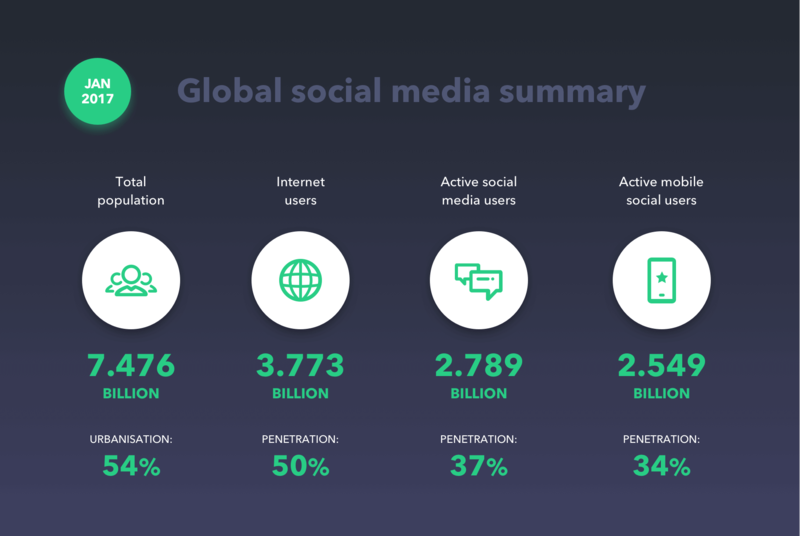The incredibly profitable sphere of social media application development motivates many IT companies to build fundamentally new projects that are not similar to any others in existence. In this article, we discuss the basic principles of constructing similar applications, including a set of universal recommendations that will help develop a truly up-to-date and popular product from scratch.
The features of building social network applications
- Adaptability with various operating systems. In view of the intense competition between personal mobile devices including Android and iOS (iPhone), it is very important to create a product that is supported on both platforms. A custom app would not only attract a larger user audience but, additionally, enhance the credibility of the brand in the IT services market.
- “Binding” well-known social networks. The application should be characterized by the ease of access to user accounts. In addition to standard registration, the option to login with the previously created social media account must be provided. Such solutions allow developers to simplify access to the application’s functionality and attract new users and the user is less likely to delete the application after seeing the registration form with a huge number of fields to complete themselves. For greater account security, try implementing two-factor verification using Twilio, for example.

- Creation of personal profiles. Social networking apps that are not profile-oriented are extremely rare. Among these is Youtube, for example. Youtube functions are aimed primarily at the distribution of various videos and the ability to create a user account is entirely optional. Nevertheless, most of the social media on this platform is aimed at the self-expression of their users. In particular, as Statista’s study shows, the greatest popularity among users in 2017 belongs to solutions in which the participants can actively promote their own accounts. Therefore, in order to increase the selling capacity of a web application, each of its users should have the opportunity to create and personalize their account with a few simple steps – upload their own photo or any other avatar, add links to their blogs or other sources that characterize personality, and provide personal information and contact details. The social media app development company should supply the capabilities for a truly exhaustive profile. In this profile, each user must be able to present themselves in the most favorable light and perhaps even improve their self-esteem. For example, Instagram offers a lot of different filters that help to significantly improve the quality of photographs and legibility of captured objects. With such options, web application clients get an incredibly simple but, at the same time, effective tool for their own use in the vast Internet world.
- Integration with existing social networks. Many existing social networks, such as LiveJournal, Facebook and Twitter, have audiences in the millions and develop APIs for integration with other products, be it native, hybrid or cross platform. By giving your users the ability to connect profiles, share posts and invite friends on other networks, you make them helpers in the promotion and distribution of your application.
- Public chats. Ability to have simple online communication with the company is key for the rapid and successful promotion of any web software. On the basis of public chats, separate dispute groups can be created. Groups may be directed towards discussing the features of application, company or production. With the help of such groups, marketers can narrow their consumer segments, optimize predefined marketing strategies, test new ideas beforehand and discover new ways for the development of the enterprise or social media network.
- Secure message exchange. Personal correspondence is a wonderful and popular way to provide communication for a web application. That is why it is necessary to think in great detail about mechanisms that can adequately ensure the privacy of such messages, eliminating the need for clients to use third-party services and programs for personal communication outside of the app.
- Instant messaging. Even today, some web apps employ the old method of sending messages or various notifications that require the page refresh to display changes. Nevertheless, most of the progressive IT companies that specialize in developing social media apps, moved away from this outdated method, preferring the instant messaging solution.
- News feed. The news feed can attract active users of your web application, allowing them to publicly share their life events, useful information, thoughts, and content they found interesting, and those who like to remain "in the shadows," giving them the opportunity to observe the regularly updated ribbon with interest, while remaining anonymous.
- Push notifications. Push notifications are delivered instantly and, with their help, it is quick and easy to simultaneously report various information to a large number of users. These notifications are less intrusive and much cheaper than SMS. Also, according to the statistics, the conversion to a subscription for push notifications can be tens of times higher than an email list. Minimum conversion of push notifications is 2%, average - 5%, and maximum - 28%. Perhaps this is due to the fact that subscribing to such notifications is much easier, as is disabling them. The less action you have to take, the better. The figures confirm this.
- Thematic communities. Social media app developers should thoroughly think over the aspect of filling solutions created by them with content. Will their application be appealing to all users? Including those who do not take an active part in "live" conversations and do not like to associate with other users? In order to popularize the application amongst this segment of consumers, it is very important to provide autonomous sources of thematic information. For this purpose, the creation of public and closed groups and communities should be supported.
- Interaction with third-party services. Bank cards and electronic wallets payments, Google maps, various databases and many other services that can expand your web application’s functionality will make it truly universal. Thus, the buyer of your product will not need to use additional resources to perform the necessary actions.
- Incentive systems. Many social networks users love to emphasize their status in every possible way. For this purpose, specially developed incentive systems are used. Typically, for this purpose, publicly visible accomplishment marks are displayed in user profiles. These can be either selectable achievements set by a profile owner or various parameters that are calculated automatically, such as the number of contacts, views, reposts, likes, etc.
- Gamification. A recent and very popular trend, gamification in online projects solves the task of involving and retaining users. At the start, the user often may not want to register. Gaming mechanics help to guide the user through the basics of the service, including usage to first purchases.

Photo credit: Reviewconnection.co.uk
- User relationships. In addition to the ability to communicate publicly and privately, developers should also provide an implicit mechanism for establishing connections between individual users. This can be an address book or a simple list of links.
- Search. In order to help users find interesting information, or friends whom they know in real life or newly acquired acquaintances, the search mechanisms must be thoroughly planned out. The search module should have an extremely wide selection of parameters and filters, and also be able to sort results according to the specific criteria.
- Autocomplete. Autocompletion expands strings of information that have been partially entered into an edit control file, into complete data. For example, when a user starts to enter a URL in the address edit control portion of the browser, autocompletion expands the string into one or more complete URL options. The system remembers and stores previously entered information, which allows it to complement and automatically fill in the repetitive fields. This helps the user avoid typing the repetitive info manually.
- Advisory notifications. Web applications designed specifically for social networks should implement the same mechanisms that are used in contextual advertising generators. Thus, the user would receive regular notifications extremely unobtrusive in nature, which, in turn, may contribute to their activities within your social media application.
- Recognizable design. The unique and recognizable logo and corporate design are no less important than a simple and intuitive interface. Practice shows that following the latest trends brings more return than creating something classical.
Three easy steps for building a social network application
1. Choose the target audience
Before creating a mobile application for a social network, you need to decide on the target audience. The more clearly it is designated, the more guarantee you’ll have that it will attract real customers to the released product. The correctness of this statement sparks a lot of sharp disputes. After all, the principles of broad targeting assume attracting buyers, the appearance of which was not foreseen by developers at the stage of a business idea compilation. Nevertheless, there is a fairly weighty factor that testifies against this type of targeting. Incredibly high expectations lead to significant finances spent on advertising campaigns, which should promote the finished product to the mass consumers. When choosing a broad target audience for the product and, therefore, focusing on carrying out numerous advertising campaigns, the team of developers should, first and foremost, ask the question: "How much does it cost?" All is well if the project budget is large - then, the high advertising cost will justify itself and entail positive results, in time. Otherwise, distinct targeting may bring more predictable revenues with lower total social media app development cost. It is impossible to say, unambiguously, which strategy is better; however, the accurate choice from the customer segment minimizes the risk of losses.
2. Carefully engineer the architecture of the application
Modern social networking apps are typically built according to the three-level model. The product is divided into three separate parts: a user-oriented front-end, a back-end that implements the application’s business logic, and databases that can store large amounts of information reliably. Only the careful planning of these three elements can guarantee the success of your project.
Front-end features were considered in detail in the first part of the article; however, the success of a social network project lies not simply on the genius of the startup’s idea and colorful design. Developers should consider the product‘s scalability and capacity to cope with heavy loads. How will the server handle a million users at a time? To reduce downtime, most IT companies create high-performance servers based on real-time Linux distributions. They are characterized by a top-of-the-line security measures and simple administration scheme. As for databases, MySQL and SQLite are uniquely winners in this area. They are ideal for processing large files and, therefore, an excellent choice for interacting with social media applications (in contrast to the recently popular MongoDB which, despite its other benefits, requires the conversion of files bigger than 16 MB).
The choice of social networks app development language is another point for careful consideration. Most of the existing languages are platform-specific. For example, iOS applications are written using Swift or Objective-C. Development teams aiming at creating cross-platform products often turn to JavaScript. JavaScript usage would allow for a user to develop a social media app for Android and iOS, or both.
3. Plan user support
No social media application can get in favor with clients without providing high-level user support. Every buyer should be able to get expert help in using the application, with the best solution as providing 24/7 service. Thus, the process of designing a social network web application must include planning of the future maintenance team and administration tools.

What else is worth noting?
- MVP. One of the most noticeable and useful trends in software development in the last decade is MVP (Minimum Viable Product). Thanks to cooperation with offshore outsource software development companies, startups today have the opportunity to receive MVP in the shortest possible time and with minimal investment. MVP embodies the essence of project ideas in order to demonstrate them to potential investors. Many successful projects have received start-up financing thanks to MVP.
- SMM. Social media marketing (SMM) is the most popular method for goods, services and mass media promotion. SMM can and should be used to advertise the developed social media application. It is necessary to start promoting the future product in social networks before its release, regularly supplying potential consumers with data on the development process and planned functions.
- Feedback. Collecting user feedback and opinions is one of the most accessible and descriptive channels for obtaining information about the application. Given the pages and groups of applications in various social networks, originally created for advertising using SMM, the feedback collection becomes simple and common.
Summary
In order to create a top-selling social networking product, it is necessary to involve a diverse team of IT specialists (developers, web designers, etc.) as part of the process. In addition, you will need to hire an experienced marketing team. Most important, however, is providing the qualitative user experience. To establish this, you will need to create a reliable, efficient and scalable server, extensive administrative capabilities, and skilled 24/7 user support team.
All in all, it is disadvantageous for most companies and startups, specifically, to hire and maintain an in-house development team, especially if the main line of business is not software development. This is where offshore outsource software development companies can be real lifesavers. We offer the services of professional UI/UX-designers, iOS and Android developers, web developers and quality assurance engineers. Contact us today and request a quote for your project!







